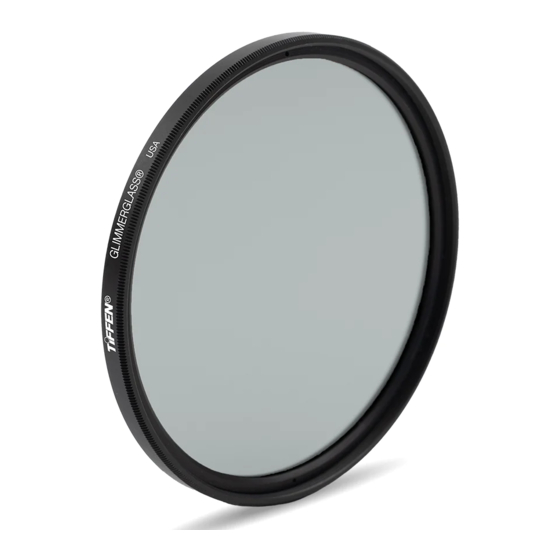
Advertisement
Quick Links
Advertisement

Summary of Contents for Tiffen Camera Filters
- Page 1 CAMERA FILTERS By Ira Tiffen © Ira Tiffen THE TIFFEN COMPANY HAUPPAUGE, NEW YORK...
- Page 2 The following will explain the basic optical characteristics of Tiffen and certain other types of camera filters, as well as their applications. It is a foundation upon which to build by experience. Textual data cannot fully inform.
- Page 3 400 nanometers (nm), the visible-UV wavelength boundary. Use a filter that transmits zero percent at 400 nm, such as the Tiffen Haze 2, for aerial and far- distant scenes; the Tiffen Haze 1, transmitting 29% at 400 nm, is fine for average situations.
- Page 4 A long focal length, however, might only image in the center of the transition. In this case, or where the blend must take place in a narrow, straight area, use a "hard" gradation. This is ideal for featureless marine horizons. For situations where CAMERA FILTERS © Ira Tiffen...
- Page 5 Polarizers can darken a blue sky, a key application, on color as well as on black- and-white film, but there are several factors to remember when doing this. To deepen a blue sky, it must be blue to start with, not white or hazy. Polarization is also angle- CAMERA FILTERS © Ira Tiffen...
- Page 6 Again, you can judge the effect through the polarizer. General Information The following filter types are available in a wide range of grades useful in both color CAMERA FILTERS © Ira Tiffen SPECIAL EFFECT FILTERS...
- Page 7 More recently, these can be obtained as standard-sized optical glass filters, the Tiffen Softnet series. These function through "selective diffusion." They have a greater effect on small details, such as wrinkles and skin blemishes, than on the rest of the image.
- Page 8 In addition, the Gold Diffusion/FX also incorporates a mild reduction of contrast, and a subtle gold “warming” tint, for improved skin tones. The Glimmerglass is the first series of filters with a ‘psychological edge.’” Tiffen has developed the Glimmerglass series of filters for “making people look their best.” A new type of diffusion filter, the Glimmerglass subtly softens fine details in a unique manner, while adding a mild glow to highlights.
- Page 9 Black Pro-Mist filters also create moderate image softening and modest-to-strong highlight flare, but without as much of a lightening effect on shadows. CAMERA FILTERS © Ira Tiffen...
- Page 10 Exposing for either highlights or shadows will leave the other severely under or over exposed. Tiffen Low Contrast filters create a small amount of "localized" flare near highlight areas within the image. This reduces contrast by lightening nearby shadow areas, leaving highlights almost unchanged.
- Page 11 "natural," less synthetic. Examples of these latter types are the Tiffen Vector-, Hyper-, North-, and Hollywood Star filters. As with any filter that has a discrete pattern, be sure that depth of field doesn't cause the filter lines to become visible in the image.
- Page 12 They are often used in combination with various neutral density filters for exposure control. They are often used in combination with Color Conversion filters. Certain #81 series filters may also be available in combination with various neutral density CAMERA FILTERS © Ira Tiffen FILTERS FOR COLOR...
- Page 13 R3's produces an R6. An R6 plus a B6 cancel each other out to produce a neutral gray. CAMERA FILTERS © Ira Tiffen K at 10,000 deg. K. This is because the filter relates to a , or one million, for convenience.
- Page 14 As produced by Tiffen, this filter is called the FL-D®, for use with daylight corrected media, or the FL-B®, for use with tungsten corrected media. Both are designed to yield good-to-excellent color under fluorescents, without the need for a meter and a variety of CC filters.
- Page 15 812® Filter The Tiffen 812 is a mild warming filter. It finds use in adding additional color to flesh tones. Bluish reflections from black skin can also be reduced. The 812 is such a useful addition that it is manufactured in combination with other effects.
- Page 16 LL-D® The LL-D was designed to help in the above situation primarily when using film. It CAMERA FILTERS © Ira Tiffen For artificial lighting, it is the light-to-subject-to-camera...
- Page 17 These are especially ideal for nature subjects. Cutting such a lens in half produces the Tiffen Split-Field lens. This can be used to have two fields of focus, one very near, the other very far, in one scene.
- Page 18 Lighting can cause flare problems, especially when using more than one filter. Lights in the image pose the greatest difficulties. They can reflect between filter surfaces and cause unwanted secondary reflections. Maintaining parallelism between filters, and CAMERA FILTERS © Ira Tiffen...
- Page 19 To facilitate making your own filters in certain standard square or rectangular sizes, Tiffen offers Net Frames. These are unique channeled metal frames that replicate the outer size and shape of 3x3, 4x4, 4x5.65 or 6.6x6.6 size filters. Use them to stretch one or more fine nets, or other material, and yet have a filter that can readily fit any standard matte box.
- Page 20 Tiffen, Color-Grad, Softnet, Soft/FX, Decamired (DM), FL-D, FL-B, 812, Diffusion/FX, Pro- Mist and LL-D are registered trademarks of The Tiffen Company. CAMERA FILTERS © Ira Tiffen...










Need help?
Do you have a question about the Camera Filters and is the answer not in the manual?
Questions and answers